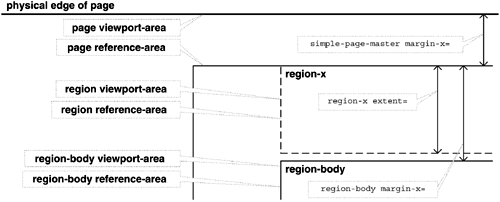7.1 Page regions , headers, and footers 7.1.1 Region dimensions Page definition is slightly different from region definitions. -
The page reference edges are top, bottom, left, and right relative to the physical medium. -
The page's viewport area is larger than the page's reference area. The perimeter region incursions must be accommodated explicitly by the body region, as shown in Figure 7-2. -
The incursion is illustrated in Figure 4-2. -
You must move the border of body region within extents of perimeter regions for the border not to interfere. -
Neither the page nor regions have border or padding rectangles. Figure 7-2. Incursion of perimeter regions into the body region  7.1.2 The region-before object Purpose Content -
( 6.4.14 ) EMPTY , -
referring object: Property sets Other required property Other optional properties -
clip ( 7.20.1 ; 368), -
display-align ( 7.13.4 ; 373), -
extent ( 7.25.4 ; 375), -
overflow ( 7.20.2 ; 397), -
precedence ( 7.25.16 ; 406), -
reference-orientation ( 7.20.3 ; 407), -
writing-mode ( 7.27.7 ; 429). Properties of note -
The region-name property is required, but the default name of " xsl-region-before " is used for this property if a name is not supplied in the XSL-FO instance. -
precedence defaults to " false " indicating that the before region does not override the start and end regions, but can be changed to " true " to stretch the region to the content rectangle of the page reference area. -
Even though padding and border-width properties are indicated as available indirectly through the common property set, these values are fixed at " 0pt " in XSL-FO 1.0. -
display-align is used to keep the information in the region snug against the before edge, snug against the after edge, or centered in the middle of the two in the block-progression direction. Excerpts from a draft of a training rendition of this material are shown in Example 7-1. Example 7-1 Regions on a page Line 01 <layout-master-set> 02 <simple-page-master master-name="frame-left" 03 page-height="11in" page-width="8.5in" 04 margin-top=".45in - .3in" margin-bottom=".45in - .3in" 05 margin-left=".6in" margin-right=".6in"> 06 <region-body region-name="pages-body" 07 margin-top=".3in" margin-bottom=".3in"/> 08 <region-before extent=".3in" region-name="pages-before"/> 09 <region-after extent=".3in" region-name="pages-after-left"/> 10 </simple-page-master> 11 <simple-page-master master-name="frame-right" 12 page-height="11in" page-width="8.5in" 13 margin-top=".45in - .3in" margin-bottom=".45in - .3in" 14 margin-left=".6in" margin-right=".6in"> 15 <region-body region-name="pages-body" 16 margin-top=".3in" margin-bottom=".3in"/> 17 <region-before extent=".3in" region-name="pages-before"/> 18 <region-after extent=".3in" region-name="pages-after-right"/> 19 </simple-page-master> 20 ... 7.1.3 The region-after object Purpose Content -
( 6.4.15 ) EMPTY , -
referring object: Property sets Other required property Other optional properties -
clip ( 7.20.1 ; 368), -
display-align ( 7.13.4 ; 373), -
extent ( 7.25.4 ; 375), -
overflow ( 7.20.2 ; 397), -
precedence ( 7.25.16 ; 406), -
reference-orientation ( 7.20.3 ; 407), -
writing-mode ( 7.27.7 ; 429). Properties of note -
The region-name property is required, but the default name of " xsl-region-after " is used for this property if a name is not supplied in the XSL-FO instance. -
precedence defaults to " false " indicating the after region does not override the start and end regions, but can be changed to " true " to stretch the region to the content rectangle of the page reference area. -
Even though padding and border-width properties are indicated as available indirectly through the common property set, these values are fixed at " 0pt " in XSL-FO 1.0. -
display-align is used to keep the information in the region snug against the before edge, snug against the after edge, or centered in the middle of the two in the block-progression direction. 7.1.4 The region-start object Purpose Content -
( 6.4.16 ) EMPTY , -
referring object: Property sets Other required property Other optional properties -
clip ( 7.20.1 ; 368), -
display-align ( 7.13.4 ; 373), -
extent ( 7.25.4 ; 375), -
overflow ( 7.20.2 ; 397), -
reference-orientation ( 7.20.3 ; 407), -
writing-mode ( 7.27.7 ; 429). Properties of note -
The region-name property is required, but the default name of " xsl-region-start " is used for this property if a name is not supplied in the XSL-FO instance. -
Even though padding and border-width properties are indicated as available indirectly through the common property set, these values are fixed at " 0pt " in XSL-FO 1.0. 7.1.5 The region-end object Purpose Content -
( 6.4.17 ) EMPTY , -
referring object: Property sets Other required property Other optional properties -
clip ( 7.20.1 ; 368), -
display-align ( 7.13.4 ; 373), -
extent ( 7.25.4 ; 375), -
overflow ( 7.20.2 ; 397), -
reference-orientation ( 7.20.3 ; 407), -
writing-mode ( 7.27.7 ; 429). Properties of note -
The region-name property is required, but the default name of " xsl-region-end " is used for this property if a name is not supplied in the XSL-FO instance. -
Even though padding and border-width properties are indicated as available indirectly through the common property set, these values are fixed at " 0pt " in XSL-FO 1.0.  |
